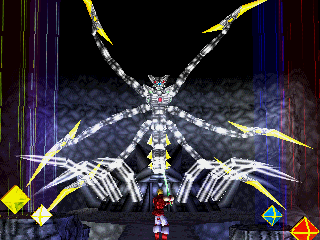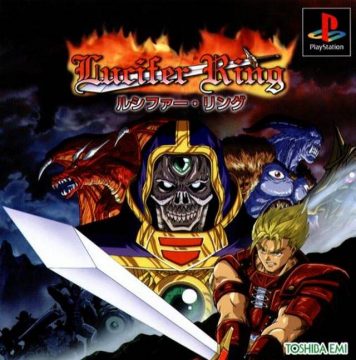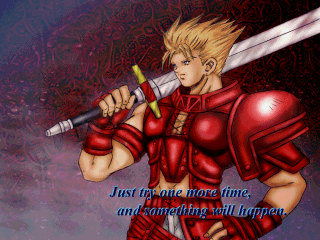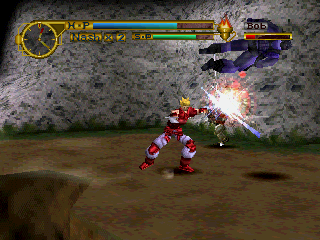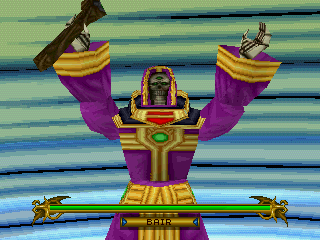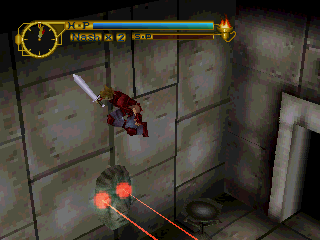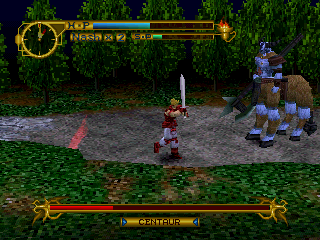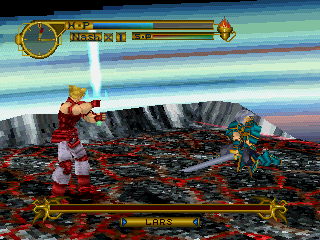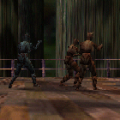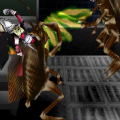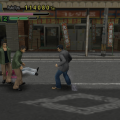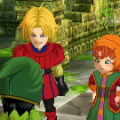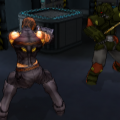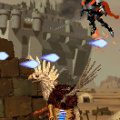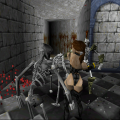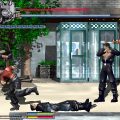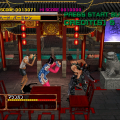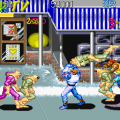Just six months after Crisis Beat, Softmachine released a somewhat more successful second attempt at a 3D beat-em-up anonymously through publisher Toshiba EMI.
It moved the setting from a modern-day Under Siege-inspired terrorist takeover of a cruise ship to the sort of fantasy land you typically see in RPGs. Fittingly, one of the background designers, Kohei Maruyama, had worked in the same capacity on the likes of Ys IV: The Dawn of Ys and Tengai Makyo II. The four characters were replaced by a single hero, a spiky, yellow-haired youth in red armor. Consequently, Lucifer Ring has no 2-player mode.
During the course of his quest, he will traverse a forest inhabited by goblins, a treant and a red dragon, ancient ruins guarded by a minotaur, a partially frozen cave and a zombie-infested graveyard to defeat the undead wizard Bair in his castle before stepping through the Gates of Hell to confront a demon in a strange limbo of floating platforms. What his quest is actually about, well, it’s hard to say, as the game is in Japanese. There are no cutscenes to speak of, anyway, just a spoken intro to establish backstory and a few lines of narration from the protagonist as he moves from one stage to the next on the world map. A rival swordsman named Lars seems to play a role of some importance, showing up twice to confront the hero before dying dramatically and fading away like a spirit.
The basic setup is the same, with a weak and a strong attack that can be combined into a few combos. The main addition is that the crowd control attack now comes with a gauge that fills up as you deal or take damage; performing it while the gauge isn’t full results in a weaker attack that costs HP, while a full gauge unleashes powerful magic. These spells depends on which sword you currently have equipped, as there are 5 swords to be found, 4 of which have special properties. The ice sword, for example, can freeze opponents temporarily, while the fire sword can set them ablaze. The fighting area is restricted by walls of red light only enemies can go through (though you can slash as them from the other side), with a counter in the corner of the screen telling you how many are left before you can move forward. Those areas are typically very constricted, with a few larger areas later on.
The biggest improvement over Crisis Beat is the level design and pacing. The individual length of stages is reasonable, with midbosses thrown in halfway through to keep things interesting; in addition to the fighting, there are traps to avoid, minor platforming segments and a few short, semi-hidden branching paths, usually leading to a treasure chest containing the best type of sword for the stage boss. Enemies are also more aggressive, though in the end the game is still too easy. The strong running attack is overpowered, allowing you to keep slashing left and right as you dash around adversaries – with one of the better swords equipped, it kills everything almost instantly. Magic attacks take out a huge chunk of the bosses’s health, and most of them can be slaughtered in seconds, rendering their patterns irrelevant. Worst of all, you’re given infinite continues, with the only penalty that you have to restart the subsection you died in. There are harder difficulty modes, but they mostly just serve to make the final battle really aggravating. Still, at just 5 stages, of which the final two are a good deal shorter, Lucifer Ring can hardly be accused of overstaying its welcome.
Finishing it once unlocks a menu from which you can choose which sword you want to use before every level, while a second playthrough unlocks a stage select menu where you can choose the specific section you want to replay, which is pretty nice as it allows you to search specifically for the few rooms or paths you might have missed. Still, while it makes for a decent playthrough, Lucifer Ring‘s lack of challenge means it isn’t much fun once you’ve seen everything.
The first generation of 3D graphics have not aged gracefully. For what it’s worth, the game doesn’t fare too badly there, with a few nice lighting effects and large character models. Apart from a decent Forest theme however, the soundtrack is just forgettable.
Perhaps, with a third beat-em-up to improve on their formula even further, Softmachine could have had a really remarkable game to its legacy. Alas, they developed a couple of WonderSwan ports instead before dissolving a few years later.
More recently, Monkey Paw Games licensed the game for a US PlayStation Store release. It’s sold as an import title, meaning the bits of voice acting are still untranslated.
